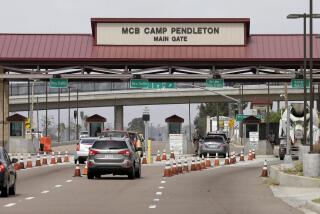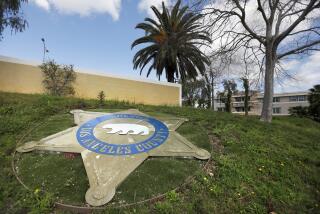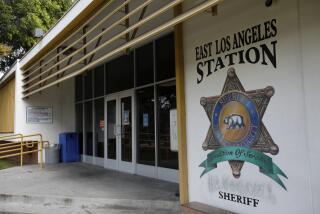Marine defends his commander
- Share via
CAMP PENDLETON — The officer who recommended that Lt. Col. Jeffrey Chessani not inspect the area where Marines had just killed 24 Iraqis testified Saturday that he profoundly regretted his recommendation because it contributed to a false report about the deaths being filed with superiors.
“Col. Chessani is not a coward,” Maj. Sam Carrasco said, leaning forward and looking directly at the hearing officer, Col. Christopher Conlin. “He’d be the first to go into a house [filled with insurgents] if we needed to.”
Carrasco, who was the battalion’s operations officer, said he thought there were too many Marines and vehicles in the battle-torn neighborhood of Haditha and that Chessani’s presence would only make things more dangerous.
He said the body of Lance Cpl. Miguel Terrazas, killed by a roadside bomb, lay in the street for hours.
“Why would we leave one of our fallen angels out in the street unless you’ve had a lot of contact?” Carrasco said, a slight tremor in his voice.
Chessani’s failure to inspect the scene of the Nov. 19, 2005, killings has become a major focus of the Article 32 hearing. Marines killed five young men on a street and 19 other Iraqis, including women and children, in or near three houses.
Chessani, who was commander of the 3rd Battalion, 1st Regiment, is charged with dereliction of duty and failure to obey an order by not calling for a formal investigation of the killings.
Conlin, who was an infantry battalion commander during the assault on Baghdad in 2003, has asked several questions of witnesses about Chessani’s failure to visit the scene.
The questions carry an implicit criticism of Chessani’s decision to stay away. Conlin told Carrasco that other commanders would have gone to the scene despite the danger.
About 18 hours after the killings, Chessani authorized a report to his bosses at the 2nd Marine Regiment that gave scant details about the killings of the civilians and, incorrectly, said that he had inspected the scene.
As a result of that report, high-level officers at the regiment and the 2nd Marine Division decided that the deaths, though unfortunate, were combat-related and no further investigation was needed.
The military began a probe only after Time magazine published an article contradicting the Marine Corps account that the civilians were killed by the roadside bomb and crossfire between Marines and insurgents.
“Sir, there’s not a day that goes by that I don’t wish we had done a better job” of looking into the incident and reporting to superiors, Carrasco said.
Even after Time magazine began looking into the killings, Chessani did not believe that an investigation was warranted, Carrasco testified. After reading a list of questions submitted by the reporter, Carrasco said, he and another officer went to Chessani to suggest an investigation.
“We said, ‘Hey, sir, this is going to get bad very fast if we don’t do something,’ ” Carrasco testified. “He raised his voice, which is something he rarely did, and said, ‘My men are not murderers.’ We adjourned the room.”
Soon after, generals in Baghdad launched an investigation that resulted in the filing of charges against Chessani and others.
More to Read
Sign up for Essential California
The most important California stories and recommendations in your inbox every morning.
You may occasionally receive promotional content from the Los Angeles Times.










